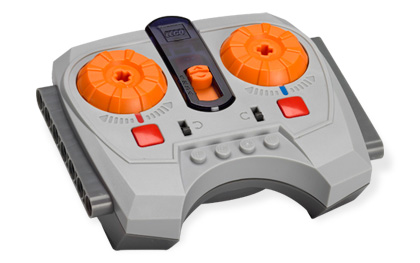| |
Hi everyone,
I just got back from Brickfest in Portland and was lucky enough to see the
unveiling of the new 10194 Emerald Night train and the new Power Functions
elements which can be used with it.

I’m not a train guy, but I had been anticipating the release of this remote in
the hopes that it would allow better and more precise control of R/C Technic
vehicles and other MOCs. After most people left one evening I spent a fair
amount of time driving the Emerald Night around the track with the new
controller to figure out how it works and how I might adapt it. Note that I am
NOT an electronics guy and have not read the PF protocol, I was merely testing
it from a practical standpoint. I’ve jotted a few of my observations below.
Based on my conclusions, it will not be very useful for controlling vehicles
other than trains. Feel free to add your own thoughts.
- The control is not infinitely variable. The control wheels have detents which offer a set of discrete power levels. From what I was able to determine, there are 5-7 of them. While this would work for an R/C vehicle, it is less than ideal.
- The signal is not continuous. When you move the dial, a short duration signal seems to be sent out. This makes sense for trains for a couple of reasons. You don’t want to have to have the remote on the whole time the train is running. You want “fire and forget”. Also, if the train is out of line-of-sight, such as in a tunnel, you wouldn’t want it to stop. So the train just keeps going with the last setting until it gets a new signal. This would not work well for R/C vehicles. First of all, the failure mode of getting out of range would be your vehicle driving off into oblivion. It also means that to slow down after driving, you couldn’t simply let go of the control. You would have to reverse the direction (or hit the emergency stop). This could be partially rectified by setting up a spring return system on the controller except for the next point.
- There is no absolute link between control wheel position and speed. Signals seem to all be relative. In other words, when I turn the wheel 1 click clockwise, it sends a +1 signal. It sends -1 for counter-clockwise. It does not send, for example, “Power Level 5”. This means that if your vehicle is out of range when you move the wheel, nothing happens. It also means that you have now lost your center point. So even if you spring loaded steering control to center, one missed IR packet would result in your steering now being off.
From what I understand of the PF system, a proper R/C system for vehicles is
possible, but this new system is clearly geared (no pun intended) toward train
control.
The new Li-Po battery, on the other hand, could be quite useful.....
Eric Albrecht
Technicopedia
|
|
Message has 2 Replies:
 | | Re: Using the new PF remote for Technic
|
| (...) .... (...) ... (...) ... (...) .... (...) Thanks for the feedback! Im not surprised the power level is not continuous, its a digital signal not analogue! iirc its 2 bytes of data, thats the mode and data for both channels in combo mode. (There (...) (17 years ago, 30-Mar-09, to lugnet.technic, lugnet.robotics, FTX)
|
4 Messages in This Thread:
    
  
- Entire Thread on One Page:
- Nested:
All | Brief | Compact | Dots
Linear:
All | Brief | Compact
|
|
|
|